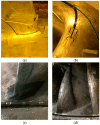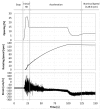Feasibility of Detecting Natural Frequencies of Hydraulic Turbines While in Operation, Using Strain Gauges
- PMID: 29320422
- PMCID: PMC5795371
- DOI: 10.3390/s18010174
Feasibility of Detecting Natural Frequencies of Hydraulic Turbines While in Operation, Using Strain Gauges
Abstract
Nowadays, hydropower plays an essential role in the energy market. Due to their fast response and regulation capacity, hydraulic turbines operate at off-design conditions with a high number of starts and stops. In this situation, dynamic loads and stresses over the structure are high, registering some failures over time, especially in the runner. Therefore, it is important to know the dynamic response of the runner while in operation, i.e., the natural frequencies, damping and mode shapes, in order to avoid resonance and fatigue problems. Detecting the natural frequencies of hydraulic turbine runners while in operation is challenging, because they are inaccessible structures strongly affected by their confinement in water. Strain gauges are used to measure the stresses of hydraulic turbine runners in operation during commissioning. However, in this paper, the feasibility of using them to detect the natural frequencies of hydraulic turbines runners while in operation is studied. For this purpose, a large Francis turbine runner (444 MW) was instrumented with several strain gauges at different positions. First, a complete experimental strain modal testing (SMT) of the runner in air was performed using the strain gauges and accelerometers. Then, the natural frequencies of the runner were estimated during operation by means of analyzing accurately transient events or rough operating conditions.
Keywords: hydraulic turbine; modal analysis; natural frequencies; strain gauges.
Conflict of interest statement
The authors declare no conflict of interest.
Figures













References
-
- International Energy Agency (IEA) Key World Energy Trends. Excerpt from: World Energy Balances. IEA; Paris, France: 2016.
-
- Huang X., Chamberland-Lauzon J., Oram C., Klopfer A., Ruchonnet N. Fatigue Analyses of the Prototype Francis Runners Based on Site Measurements and Simulations. IOP Conf. Ser.: Earth Environ. Sci. 2014;22:012014. doi: 10.1088/1755-1315/22/1/012014. - DOI
-
- Ohashi H. Case Study of Pump Failure Due to Rotor-Stator Interaction. Int. J. Rotat. Mach. 1994;1:53–60. doi: 10.1155/S1023621X94000059. - DOI
-
- Egusquiza E., Valero C., Huang X., Jou E., Guardo A., Rodriguez C. Failure investigation of a large pump-turbine runner. Eng. Fail. Anal. 2012;23:27–34. doi: 10.1016/j.engfailanal.2012.01.012. - DOI
-
- Trivedi C. A review on fluid structure interaction in hydraulic turbines: A focus on hydrodynamic damping. Eng. Fail. Anal. 2017;77:1–22. doi: 10.1016/j.engfailanal.2017.02.021. - DOI
LinkOut - more resources
Full Text Sources
Other Literature Sources

